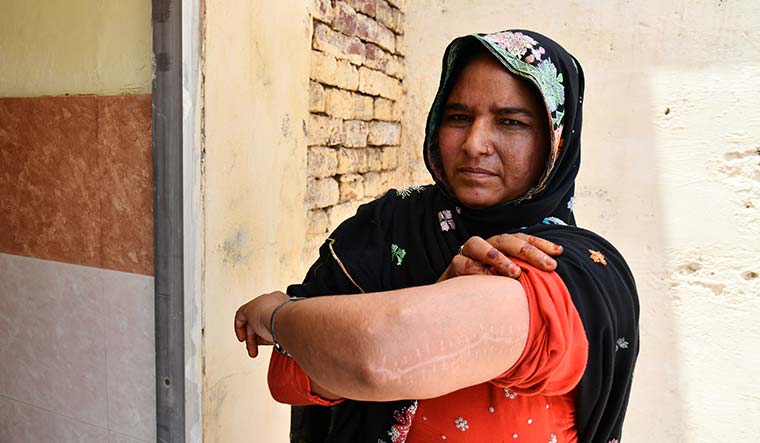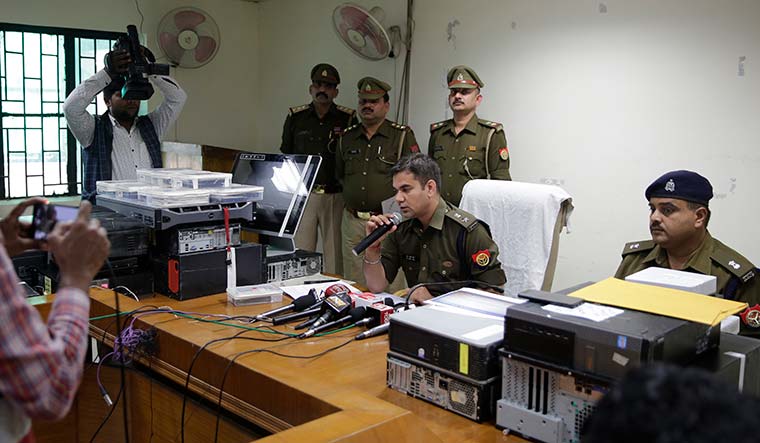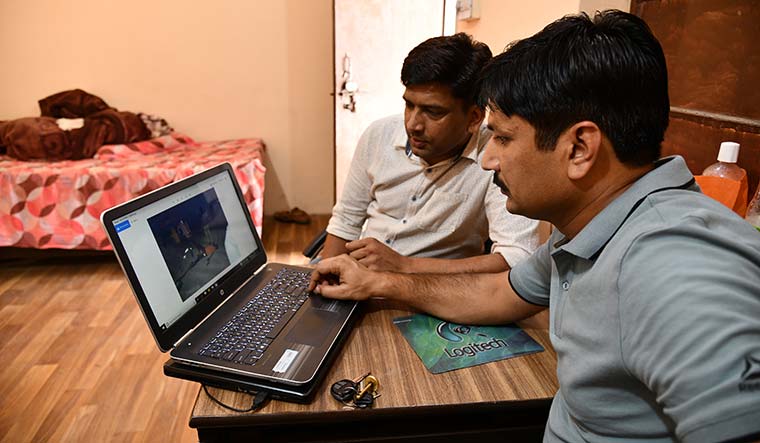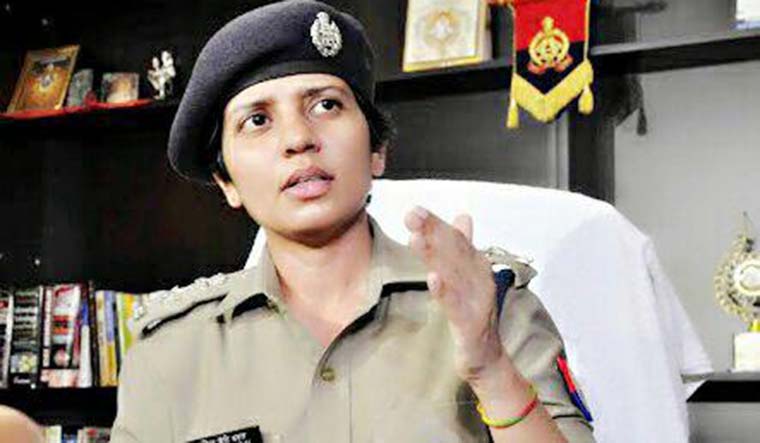At 2.30am on June 17, 2017, a special police team led by Ajay Pal Sharma, IPS, entered a dense mango orchard in Uttar Pradesh’s Shamli district. Sharma was senior superintendent of police in Shamli, and he had received a tip-off that a fugitive with a Rs50,000 bounty on his head had turned up at Bhabisa village to plan the killing of a businessman.
The fugitive was Vipul aka Khooni (murderer), a tag he earned after he decapitated a victim. There were nearly two dozen murder and extortion cases against Vipul, the most notorious ones being the killing of a woman grampradhan in Saharanpur and a bank robbery in Muzaffarnagar. The police had also identified him as one of the two motorcycle-borne assailants who had shot dead local BJP leader Raja Valmiki outside his shop in Khatauli, Muzaffarnagar, in April 2017.
Sharma’s tip-off was that Vipul would take a concrete road that ran through the orchard to travel to the nearby Hurmajpur village. The police team’s plan was to ambush him.
A police team of this kind usually has five or six policemen led by an SSP or SP. There would be surveillance and intelligence experts and marksmen, all prepared for any eventuality. That night, though, Sharma’s team had to improvise. Vipul and his gang spotted the police and opened fire. The gunfight lasted an hour and a half, during which Vipul was shot in both legs; two constables were also injured. Vipul is now in Meerut jail.
What Sharma and his team did that night became a template for the rest of the state. More than two years since, shootouts between gangsters and the police have become so commonplace that Uttar Pradesh has become India’s encounter capital. There have been 3,989 police encounters after Yogi Adityanath became chief minister in March 2017. As many as 77 criminals have been killed, more than 9,000 arrested and 1,198 criminals injured in encounters between March 20, 2017, and June 11, 2019. The Yogi government says it is proud of the dipping crime rates in UP, and it recently gave an award to Sharma for his outstanding contribution in maintaining law and order in the state.
Encounter specialists like him are now in the spotlight. But Sharma himself believes that his job is misunderstood and glamourised. “I left the medical profession to join the police force because I thought this was a better way to serve the people,” said the 31-year-old former dentist. “When a criminal fires at a policeman, his sole aim is to kill him; it is not so for the policeman. It is easy to criticise police action, but when bullets are fired, the choice is between allowing policemen to get killed or shooting down the criminal.”
Extortions, kidnapping, murder and dacoity have been commonplace for decades in towns like Shamli, Meerut, Muzaffarnagar, Bulandshahr, Ghaziabad, Kairana, Baghpat, Saharanpur and Noida. “In the last 10-15 years, the situation was so bad in western UP that people started moving out of the region,” said Prashant Kumar, additional director general of police, western UP. “Criminal gangs used to extort money from businessmen and ordinary people. What has changed today is that law-and-order has become top priority. There is zero tolerance of crime, criminals and corruption. The government has handpicked a few officers and given them clear instructions. The nexus [that controlled] postings in the police department has also been broken; merit alone counts now. Field officers have to perform or perish.”
The first big challenge for the UP Police came after the Muzaffarnagar communal riots in 2013, when families terrorised by gangsters started migrating. According to the BJP’s state unit, the worst hit was Kairana district, from where nearly 250 Hindu families fled.
The police found that the exodus was largely because of the Mukim Kala gang in the region. A dreaded gangster who had political connections, Kala had against him nearly 50 cases of murder, extortion and kidnapping in UP, Haryana and Uttarakhand.
In the run-up to the 2017 assembly polls, the alleged exodus of Hindu families from Kairana became a political hot button. The BJP promised to bring parivartan (change) in the law-and-order situation, and it helped the party win a big majority.
Little did Sharma know that the promised change would begin with him.
On March 21, 2017, two days after the Yogi government was sworn in, Sharma got a call saying that Mohammad Furqan, a sharpshooter from the Mukim Kala gang, was demanding Rs2 lakh from a trader. With the Kairana exodus still fresh in memory, Sharma assembled a team and began the hunt for Furqan.
A month later, Furqan was spotted in a place between Kairana and Kandhla. The police surrounded the place at night and arrested Furqan after an encounter. He was shot several times in his legs. With more than 30 cases against him, Furqan is now in Muzaffarnagar jail with 27 associates who provided him shelter and logistical support.
In July, Sharma’s team killed two men in encounters. Naushad Dani and Sarvar were wanted in Haryana and Uttar Pradesh for murder, robbery and extortion. In an audio clip in possession of the UP Police, Dani is heard saying, “I will kill anyone who gives information to the police. I am not afraid of the police. What can they do?”
A lot, apparently. “If the criminal shoots at us, we would shoot him dead,” said a senior officer. “It is not as if there is any written instruction from the government, but the unspoken word is that no criminal will be spared.”
Officers like Sharma, who have been posted across the badlands of western UP, do their job without compunction. “We follow all rules and regulations,” said Manzil Saini, a 2005-batch IPS officer and the only woman officer in western UP who has been part of multiple encounters. She was nominated for the President’s Police Medal this year.
Saini’s approach to policing has won her the nickname Lady Singham (lion). “I have served as the superintendent of police in the worst of districts of UP,” she said. “In Firozabad, I had a very emotional experience when a child was kidnapped. It became a sensational case and we had a tough time securing the child. Each time I met the mother, she would cry and beg for her child’s safe return, and question police inaction. Being a mother, I would be moved to tears. In one such emotional moment, I was caught by the local media wiping my eyes and it became the talk of the town. We are also humans after all.”
Firozabad is known for its bangles. According to Saini, people would sometimes gift bangles to policemen who were not tough on crime. “Thankfully I did not have to wear them,” she said, smiling. “My team worked through nights and finally succeeded in recovering the child, though we could not catch the kidnapper. I still remember the joy on the mother’s face.”
Months later, the person who was alleged to be the kidnapper was shot dead in an encounter by Saini and her team. The grateful residents of Firozabad paraded her through the streets on horseback.
Saini was part of the force when Mayawati’s Bahujan Samaj Party and Mulayam Singh Yadav’s Samajwadi Party were in power. “Police encounters have taken place under all regimes,” she said. “But what is different this time is that the police have been given a free hand to act against any criminal, irrespective of his political affiliation, caste or religion.”
When the Samajwadi Party was in power, Mulayam’s family priest, Pandit Ramesh Tiwari, was shot dead by two unidentified gunmen outside his house in Jaunpur. Saini and her team tracked down the two accused; they were killed in the ensuing encounter.
When Yogi set up anti-Romeo squads in Lucknow—one of his first decisions since coming to power—Saini was made the first woman SSP of the capital city. To nab eve-teasers, she deployed plainclothes policemen at tea stalls outside colleges and at public places. Initially, anti-Romeo squads had 26 vehicles at their disposal, but it soon lost manpower and facilities. “To curb crime rates, we need more policemen on the ground,” said Saini. “If there is more manpower and better policing infrastructure, crime rates will automatically go down.”
There is an acute shortage of policemen in UP. There are only 119 policemen for every one lakh citizens, which is well below the United Nations standard of 222 policemen per lakh people. UP needs 1.14 lakh more police personnel.
There is criticism that the rising number of encounters are meant to mask the policing deficit. Opposition parties allege that the police are staging encounters to bring down crime rates and win accolades for the state government.
BSP chief Mayawati has alleged that members of a particular community are being targeted. “The police encounters in the last six months raise questions [about] whether only members of a particular class or community engage in crime or become history-sheeters,” she said last year.
Former chief minister Akhilesh Yadav said police encounters deflected attention from the reality that law and order had worsened in places where encounters had taken place. According to him, people are falsely branded as criminals and then killed in encounters.
ADGP Prashant Kumar admitted that there were indeed some “trigger-happy policemen”. But, he said, there were departmental checks and balances to prevent wrongdoing. “Two cases of police excess have happened in Noida and Lucknow, where police officers went beyond their brief and misbehaved with the public,” he said. “The first was the case of a 25-year-old gym trainer who was shot by an inspector after an argument in February last year. The inspector was arrested and three others were suspended. In the second case, a constable shot an executive of a multinational company who was in a car with a woman colleague. The constable is now serving a jail term.”
The National Human Rights Commission has looked into 18 instances of encounters in the past two and a half years. The United Nations high commissioner for human rights has also raised alarm over the extra-judicial killings. “We are extremely concerned about the pattern of events: individuals allegedly being abducted or arrested before their killing, and their bodies bearing injuries indicative of torture,” said the UN human rights body in January this year.
Head constable Jaiverdhan does not agree with those who criticise the police. An encounter specialist, he is part of the SWAT (Special Weapons and Tactics) team of the Meerut Police crime branch, which was involved in several high-profile encounters in the past two years. “Are we paid extra to chase criminals and kill them? The answer is no,” he said. “It is only a handful of us in each district who risk our lives. Unlike the criminal, each bullet fired by us has to be accounted for. We have to defend each action.”
Jaiverdhan was at his office in a dilapidated building in Meerut, which serves as the police headquarters of western UP. The room, which was just big enough to accommodate four people, had a bed and some utensils. Jaiverdhan’s colleagues pulled up a chair for me, and said this was the best they could provide.
“We work, eat and sleep here since we spend days and nights chasing criminals. We are tracking them electronically and need to be ready to move out anytime,” said Varun Sharma, the inspector who heads the SWAT team. “These days criminals move in fancy SUVs, but we get a bicycle allowance.”
Policemen like him are worse off in other parts of the state. Many of them work in makeshift structures with tin roofs and they often shun the uniform to avoid being detected. They put their sidearms in the back-pockets of their jeans and secure them with strings.
At the Meerut office, the police carry out surveillance using basic cellphones and laptops. The operations, however, are so effective that they have managed to carry out several police operations in and around Meerut. In May this year, the SWAT team tracked down dreaded gangster Zubair, a resident of Lisari Gate who allegedly led a gang that was at large in Gujarat. The Gujarat Police had been chasing Zubair ever since his name cropped up in a case involving the extortion and murder of a diamond trader in Surat on March 5.
The operation against Zubair was led by Sharma, Jaiverdhan and deputy superintendent of police Jitender Kumar Sargam. A tall, well-built man, Sargam hails from Rohtak in Haryana. He was a professional wrestler before he joined the police through sports quota. “I hail from a family of bodybuilders and have earned a lot of respect in my village after joining the police. To lead operations, one needs to be very fit. I eat dal, roti and a lot of vegetables every day with two huge glasses of milk,” said Sargam, as he sat down for lunch prepared by his wife. According to his wife, families of police officers used to lead risky lives, but things are changing now.
Sargam has won honours for his bravery, and the Zubair case is the latest feather in his cap. The victories, however, always come with a price. When Sargam and his team surrounded Zubair and his gang, a gun battle ensued and constable Kulwant Singh was shot in the leg. “Sometimes I feel the pain in the leg,” said Kulwant. “My family was distraught. I have small children and I am the only earning member in my family.”
But there is no stopping policemen like Kulwant. It was because of them that the SWAT team in Meerut was able to finish off the extortion racket run by the dreaded gangster Noor Mohammed alias Haseen Mota, a gunman from the Mukim Kala gang.
“Haseen Mota, a resident of Lisari Gate in Meerut, used to loot butchers who travelled with large amounts of cash to buy livestock,” said Nitin Tiwari, senior superintendent of police in Meerut. “He started as a petty thief, but his confidence grew when he joined hands with Mukim Kala. He started extortion and made money by resolving property disputes. No one dared complain against him.”
Mota did not use cellphones, which made him difficult to track. According to the police, he and his associates were on their way to commit a crime when he was stopped at a checkpoint. Caught off guard, Mota fled the scene on his bike but was soon surrounded by the police. He opened fire first, said the police, and was killed in the encounter. The police recovered .32 bore and 9mm pistols from the spot where he was killed.
Mohammed Vakil, Mota’s elder brother, said he was killed in a fake encounter. “We had separate businesses and he took the wrong path,” said Vakil. “His actions might not have been clean, which was why the family also turned against him. When your own parents get angry, then the world is not with you.”
Vakil said Mota was poisoned. “My brother was huge; he had a lot of strength,” he said. “My two hands were equal to his one hand. The police laid a trap for him. One day, he was called to his friend’s house for tea, on the pretext of helping him in the two dozen police cases that were slapped against him. There they mixed something in his tea and killed him. And later it was shown that he was killed in a police encounter in Partapur.”
The police deny the allegation. “While there are various platforms to raise a criminal’s point of view, there is none for the police,” said SSP Nitin Tiwari. “The police are the only department that faces accusations and criticism and still fights for the public.”
He said the police should be empowered in more ways. “If the police do not have access to the Aadhaar database and the fingerprints of the deceased, then what is their use to the public? They can be crucial evidence in a case. We also need to regulate the sales of arms and ammunition. There are villages in UP that have been manufacturing country-made weapons over generations. Even if [the culprits] get arrested, they come out of jail and start doing the same thing. Also, we need courts to speed up trials, because if a case drags on, the criminals intimidate witnesses and manage to get bail.”
Satpal Antil, superintendent of police in Muzaffarnagar, said he spent half his workday ensuring the safety of witnesses in cases involving gangsters. One such witness is Sanjeeda alias Moti, a resident of Kulhedi village. Moti was terrorised and shot in her home allegedly by Rehan, a dreaded gangster belonging to the Mukim Kala gang.
“The criminals thought I was a police informer because I had raised my voice against crimes in my village,” said Sanjeeda. “One day, five men entered my house and started shooting. Eleven bullets hit the wall and the others injured me even as I held on to my small child.”
Rehan is on bail now, but Moti does not have full-time police protection. “The police are helpful. They keep checking on me now and then. I fear for my life, but I will continue to raise my voice against these criminals,” she said.
Anil Kaparwan, station house officer at the nearby police station, said that it was the courage of women like Sanjeeda, rather than the fear of the gun, that keeps gangsters in check. Kaparwan is a recipient of the President’s Police Medal for gallantry.
The camaraderie between people like Sanjeeda and the police seems to be the reason people are returning to their homes in Kairana and other crime-ridden districts in western UP. The fear of police crackdowns is such that gangsters are cancelling bail on their own. Mukim Kala, who is in a jail in Haryana, recently asked the court to keep him incarcerated. He said he feared getting shot in a police encounter.
The debate on the legality of the encounters is still raging. Sources told THE WEEK that the National Human Rights Commission has filed closure reports in at least eight of 18 cases it had been investigating. Apparently, the NHRC found no evidence that the encounters were staged.
According to Yogi Adityanath, people in the state feel safe now. “Also, the morale of the police, which was low under previous governments, has rebounded,” he said. “To a large extent, we have got rid of the atmosphere of fear.”








